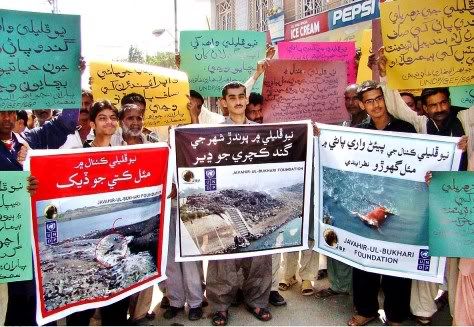I had never been overly optimistic about cleanliness of our drinking water sources, but following two photos hit too close to reality. Pakistan’s 6th largest and Sindh’s 2nd largest city, Hyderabad draws its drinking water from Phuleli Canal (official spellings – Fuleli). The photos in this post show protest by an NGO in Hyderabad against pollution in the Phuleli canal.

Click on the photo above to see a larger image. If you look at the photos and language of posters these guys are holding, they show corpse of a dead horse and a dead dog in water. One poster shows a hill of city’s solid waste getting mixed in the water.
According to a study the amount of nitrogen and phosphorous added to Phuleli canal from sewage water were calculated to be 316.2 tons/month and 85.3 tons/month respectively.
Hyderabad with 1151274 people (1998 census) has two water treatment plants on Phuleli Canal. Northern Water Treatment plant and Southern Water Treatment Plant. It is true that water from Phuleli canal goes to 2 these plants before it is supplied to city population, but I wonder how much and how efficient of flitration is done in the plant? Also not everyone along Phuleli Canal gets to drink filtered water. There are several towns downstream from Hyderabad e.g. Matli (41995 people), Tando Mohammad Khan (62087 people) and Badin (61302 people) which get their water untreated and directly from the canal.
 A survey report from 2006 states that Highly toxic run-off from plastic factories, illegal cattle pens, slaughterhouses and sewage water is released into the Phuleli canal as it passes through Hyderabad and it has put in jeopardy lives of more than a million people. Following is an extract from Dawn news which talks about this 2006 survey of Phuleli water:
A survey report from 2006 states that Highly toxic run-off from plastic factories, illegal cattle pens, slaughterhouses and sewage water is released into the Phuleli canal as it passes through Hyderabad and it has put in jeopardy lives of more than a million people. Following is an extract from Dawn news which talks about this 2006 survey of Phuleli water:
Various industries, cattle pens and slaughterhouses situated between RD-4 and RD-38 in Hyderabad, throw tonnes of solid and fluid waste into the canal. Two plastic factories located between RD-22 and 27 in Laloo Lashari and Khursheed Town drain out their garbage and run-off into the canal. At RD-27, some people clean solid waste from floor mills on encroached land on the canal, which is not only telling upon their health but is also polluting water.
A Historic Photo of Phuleli Canal:
 Phuleli Canal has been supplying drinking water to Hyderabad from days of its construction. Photo to the left shows a Persian Wheel drawing drinking water from Phuleli canal in 1890s. This photograph is from an album of 91 prints apparently compiled by P. J. Corbett, a PWD engineer in canal construction in Sindh in the early 1900s.
Phuleli Canal has been supplying drinking water to Hyderabad from days of its construction. Photo to the left shows a Persian Wheel drawing drinking water from Phuleli canal in 1890s. This photograph is from an album of 91 prints apparently compiled by P. J. Corbett, a PWD engineer in canal construction in Sindh in the early 1900s.
So Why This Post?
Why am I writing this post? I was shocked to see photos of dead animals in the water supply of Hyderabad above. I also want to raise awareness about pollution in canals taken out from lower Indus i.e. Kotri Barrage. Many years ago river Indus used to flow much fuller here but with less and less water reaching Kotri barrage, effluents are not getting washed away from the river as well as canals like Old Phuleli (Pinyari Canal), New Phuleli (Fuli Canal), Kalri Baghar Feeder Upper, Akram Wah (Lined Channel), Wadhu Wah and Fasadi Wah which feed huge population with drinking water. Adding to the problem is local practise of dumping waste and effluents in the canals themselves.
References:
(1) Population of Hyderabad according to 1998 census was 1,151,274. Source here
(2) Industries told to Stop Toxic Effluent Disposal in Indus
(3) Toxic water in Phuleli canal poses threat to people
(4) Historic Photo of Persian Wheel at Phuleli Canal: here
(5) Quantitative Assessment of Phosphorus and Nitrogen in Fuleli Canal Water
(6) Physico-Chemical Study and Budgeting of Wastewater From Hyderabad City Limits
(7) Map of Hyderabad
Photo Credits: Farhan Khan at Associated Press of Pakistan – Clicking on the photos above will take you to their parent website and larger size images.



















































for water treatment filter plant
These particular posters are actually not in Urdu but in ‘Sindhi’. If however, you can read Urdu then you can pretty much read most of the Sindhi characters too.
use of Urdu banners, signboards and posters in Pakistan is widespread. It has truly been the lingua-franca for Pak. When people of different regions and provinces in Pakistan cannot communicate with eachother, they use Urdu or its variants as written and spoken communication.